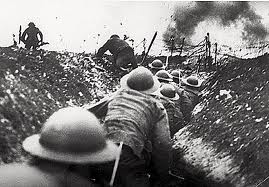The Somme offensive was the main Allied attack along the Western Front in 1916. Launched on July 1st along a 19 mile front line north of the River Somme between Amiens and Péronne, it eventually ended on 18th November due to bad weather.
Originally intended to be an offensive dominated by French forces, with the British in support, it’s primary objective would be to smash the German army and deplete their manpower reserves. This was never going to be a nimble, clever campaign. Oh No. Just brute strength and attrition please waiter.
As it was their show, the decision to launch the offensive in the Somme region was down to the French high command, and it was down to the location of available manpower and resource rather than any grand strategy or plan. Haig preferred an attack in the north of Belgium to check the growing U-boat problem emanating from the Belgian ports but the politics of the situation forced him to comply. So everything was agreed. Hands were shook, backs were patted and cigars lit. The ‘big push’ was pencilled in for August 1916.
But, being the party poopers they are, the Germans messed up all the plans when they launched their own offensive at Verdun at the beginning of 1916. Suddenly France was the one being ‘bled white’ and within a few months it was clear that France would not be in any fit state to lead a major offensive. In fact it was touch and go as to whether they would survive as a fighting unit. They needed help from Britain to relieve the pressure at Verdun, and they needed it fast.
So, the date of the attack was brought forward to the beginning of July, and it was now a large scale British diversionary attack, with only minimal French support. Planning passed to Haig, and it was game on.
The plan was simple: Mass more guns than have ever been massed before to fire more shells than had ever been fired before, for longer than had ever been done before. This would completely smash the German defences, cut their wire to smithereens and shatter the resolve and morale of the enemy soldiers. Then, the infantry, some 750,000 men (of which a large portion were made up from Kitchener’s new Pals Battalions), would advance and consolidate the positions, with cavalry at the ready in order to attempt a complete breakthrough if the opportunity arose.
Despite a monster 8 day bombardment, a mixture of poor quality ammunition and world class underground German bunkers resulted in failure. Wire was not cut, morale had not been broken, defences were still intact and when the infantry attacked the German positions at 7.30am the German machine gunners and artillery were ready and waiting.
The result was carnage. The British Army suffered almost 58,000 casualties on this one day. A third of these were killed. To this day it stands out as the blackest moment in the Army’s illustrious history. Apart from the odd isolated success the large bulk of the British infantry were either cut down in No Man’s Land or forced back to their own lines. Ironically it was the French, that made the best progress towards the south of the front.
Despite everything, Haig persisted with the offensive in the following days. Advances were made, but these were limited and often ultimately repulsed. On the 11th July the first line of German trenches were secured. On that day German troops were transferred from Verdun to contribute to the German defence, doubling the number of men available for the defence.
Like punch drunk boxers, both sides thought they were one decisive blow away from total victory, so they kept smashing each other in the face, time and again. There were minor successes such as the Australian capture of Poziers on July 23rd, but these were isolated victories and could not be capitalised upon.
On the 15th September, the British attacked again in the Battle of Flers-Courcelette. It was here that the tank made its operational debut, and although it scared the hell out of the enemy, these early ‘land ships’ failed to make a great impact and the advance only gained a few kilometres.
The sparring carried on until the November snow forced the final suspension of operations. Allied forces had gained a slither of tortured landscape 12km across at the deepest point.
Over a million men became casualties during this bitter struggle, with Britain and her Empire suffering to the tune of 419,654 men, wounded and killed. However, the Germans suffered terribly too (around 500,000 casualties), and they were forced to stop attacking Verdun allowing the French army to dust itself down and regroup. So while the tactics of Haig remain controversial even to this day, the offensive achieved the desired effect: Relieve the pressure on the French at Verdun, and inflict huge casualties on the Germans. So from a purely military point of view, he could be excused for saying ‘job done’.




Leave a comment